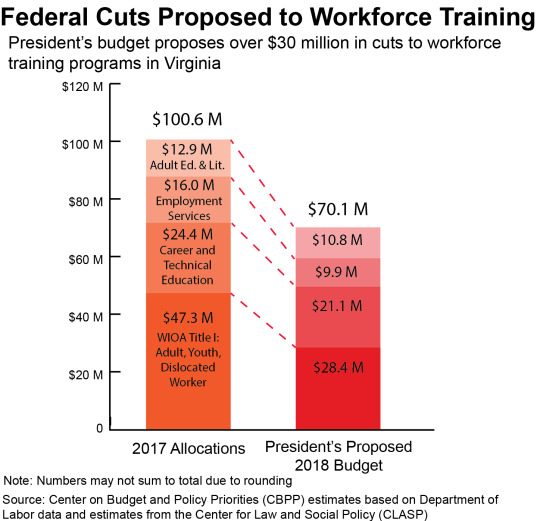June 28, 2017
Virginia’s Workforce Training Programs Are Successful, Popular — and on the Chopping Block in D.C.
The President’s recently released proposal for the 2018 federal budget features deep cuts in assistance programs that help struggling families and slashes funding for a range of public services and investments. Included in the cuts are drastic reductions to workforce training programs that have had widespread bipartisan support as important investments for building a strong workforce and economy. Many people and employers across the commonwealth depend upon these programs.
This includes a forty percent cut – $18.9 million – to adult, youth, and dislocated worker funding under the Title I of the Workforce Innovation and Opportunity Act (WIOA). These programs help recently laid off workers retool their skills in promising fields. They help kids that dropped out of school and those at risk of dropping out find paid work, grow their skills, and get back on the right track with their education. They help out of work adults find employment opportunities. They strengthen Virginia’s workforce and make the state a more attractive destination for employers.

The federal government is the primary funding source for WIOA services in Virginia – meaning the federal reductions proposed by the President would significantly disrupt and likely eliminate workforce training opportunities.
WIOA received widespread, bipartisan support – it’s one of the few areas where democrats and republicans in D.C. have recently found common ground – when it was approved in 2014. The Act has been lauded for its design to streamline services, promote the use of evidence-based practices like sector strategies and career pathways, and for encouraging partnerships with employers. Reviews of programs prior to the passage of WIOA, including a Virginia study, show positive returns on investment for participants and reduced reliance on public assistance after 5 years.
The President’s proposed budget also calls for cuts to federal support for career and technical education (CTE) in Virginia’s public schools. Schools offer these courses in grades 6-12 to train students in promising career fields and earn industry recognized credentials. These courses offer students a career pathway that allows them to sidestep the rising cost of tuition at four-year colleges and enter the job market with sought-after skills and expertise. The President’s proposal cuts federal CTE support nationally by 14 percent, resulting in millions of dollars in cuts here in Virginia.
These proposed cuts won’t just affect students. They also hurt employers who are in need of workers with the skills these classes teach. In a survey of school CTE directors, CTE classes in the highest demand from employers were in areas such as the health sciences, information technology, and manufacturing, which can require costly equipment. If schools don’t have resources, they won’t be able to offer courses in these fields.
These reductions in federal support would also come as Virginia looks to ramp up work-based learning opportunities and CTE offerings as part of new high school graduation requirements. The Virginia Board of Education is currently developing a “profile of a Virginia graduate” that will be used to create new standards for high schools in the state – emphasizing a need for career exploration and work-based learning in high school. The federal cuts will undermine our ability to implement these new innovative strategies supported by democrats and republicans here in the state.
The President’s budget proposal is a bad deal for Virginia’s communities and our economy. It’s critical that Virginia’s congressional leaders reject this dangerous cost-shift to the state, and put the needs of all Virginia families at the top of the agenda.
Category:
Education
